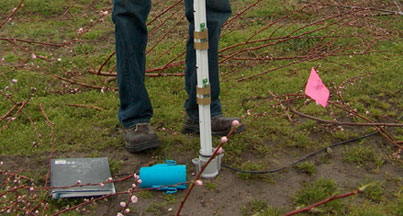MCGILL'S WATERWORLD
Helping growers save water

C-probe water-sensor
Water is an increasingly precious commodity for most Canadian fruit and vegetable growers. And with the growing demand, user fees, and the need for permits required to take water, efficiency in irrigation has become a crucial part of agriculture in Canada.
A Brace Centre for Water Resources Management initiative called Determining Irrigation Needs by Monitoring On-Farm Soil Moisture is trying to help Canadian growers by introducing them to and training them to use water-sensor technology that will lead to more efficient water use. The year-long project took place in four areas in southern Ontario. Growers at 19 farms were introduced to sensors that could accurately measure the amount of water in soil, allowing them to determine when to irrigate their peaches, strawberries, peppers and tomatoes.
"Growers need to know when to turn that irrigation switch on and when to turn it off," said Bano Mehdi, Professional Associate at the Brace Centre and Project Manager on the sensors initiative. "When it comes to irrigation, most growers are flying by the seat of their pants. Right now they do the "feel" method – they kick the top 10 cm off with their boot and take a grab sample to feel the soil with their hands. But that leaves a lot to be desired in terms of accurately determining how much water to apply. That's why we think these sensors are a great way to get growers to irrigate more efficiently. That's what it's all about – saving water."
The Brace Centre and McGill's partners on the project included the Ontario Ministry of Agriculture, Food and Rural Affairs (OMAFRA), Agriculture and Agri-Food Canada, the Weather Innovations Network (a private consulting firm) and the growers themselves. Funding was provided by the Canada-Ontario Water Supply Expansion Program (COWSEP).
The project introduced the growers to six different types of sensors of varying complexity – from basic models that could be inserted into the soil and read via a dial gauge, to wireless ones that could send data to remote computers.
"The sensors the growers liked best were the ones that relayed data directly to their computer," Mehdi said. "You get this beautiful graph in near real-time that would show you what's going on in the soil in terms of volumetric water content at the different depths where the sensors have been inserted."
These sensors are not yet widely used, and certainly not to their full potential. Wireless technology, for example, now allows for a network of sensors and computers to be set up. Even those without sensors installed on their farms could opt-in and have access to information. The possibilities, like the potential savings, are considerable. A number of the growers have already expressed an interest in investing in the technology.
"We opened up a whole new world to them," Bano Mehdi said. "They were blown away with what they could do with the technology and a lot of them are sold on it now."

